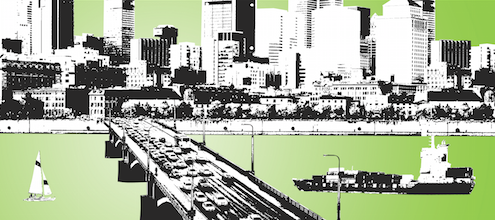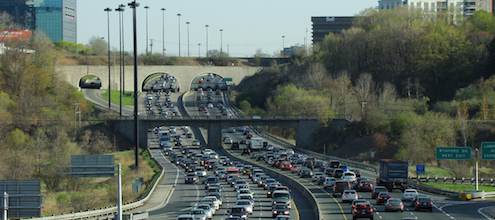
How should road congestion in Metro Vancouver be priced?
If you ever find yourself at a random party in Metro Vancouver and are struggling to make conversation, asking about the region’s traffic woes is a guaranteed ticket for a lively debate. Metro Vancouver has some of the worst traffic in Canada, and is intensifying with the region’s rapid population growth and confined geography. The Mayor’s Council has signalled that relief could be on the way with the introduction of mobility pricing by 2021. But the ultimate design of mobility pricing in Canada’s west coast metropolis will have big implications.
What is mobility pricing?
First let’s start with the basics. Mobility pricing—also called congestion pricing—is a way to reduce traffic by charging drivers a small fee to use certain roadways or bridges. The user fee can be a fixed amount, or it can fluctuate depending on the time of day, or by actual congestion levels. The point of mobility pricing is to make each driver more aware of the costs they impose on other drivers, and the city as a whole. Pricing congestion has been implemented in many jurisdictions around the world, and has proven itself as a very effective tool in reducing traffic (with benefits to drivers and citizens alike).
How might mobility pricing work best in Metro Vancouver?
This week marked a milestone in the development of mobility pricing in Canada. The Metro Vancouver Mayor’s Council committed to implementing mobility pricing by 2021. While the idea isn’t new in the region—and still requires provincial support—it’s a big step forward. The conversation is shifting from whether mobility pricing is the right policy, to how it can be smartly designed and implemented.
That being said, the “how” is pretty important. The design details of mobility pricing will be critical in shaping its fairness and ability to reduce gridlock. The Ecofiscal Commission released a report in November that looked, in part, at mobility pricing in Metro Vancouver. Given its unique geography, infrastructure, and governance structure, we proposed two approaches: toll each of the region’s bridges and tunnels, or a more comprehensive distance-based tolling system.
The idea of tolling the region’s bridges and tunnels has been around for over a decade. Many trips in the region involve a water crossing; tolls would therefore catch a large portion of traffic and help alleviate some of the region’s congested hot-spots. Bridge and tunnel tolls could also be introduced relatively quickly—the technology is already used on two bridges in the region.
Tolling only bridges and tunnels, however, could leave a large swath of trips in the region un-tolled. Someone living in Coquitlam, for example, could drive to downtown Vancouver without facing a single toll. Meanwhile, a resident making the same trip from Delta could pass over as many as three bridges. So not only does this leave congestion unaddressed in big chunks of the region, but it could also be unfair to the parts of the region with more bridge/tunnel crossings.
Although more challenging to implement, we also proposed the idea of a distance-based, per-kilometre form of mobility pricing. This form of mobility pricing can charge drivers based on the time and distance of road-use, and could apply to everyone in the region. The technology for this type of mobility pricing is becoming readily available, and the system in Oregon proves that it can be done well.
It’s safe to say that a distance-based system is a more comprehensive way to tackle the region’s congestion than bridge tolls, but it is nevertheless a complex system to implement. Even though the Mayor’s Council has given themselves five years before introducing mobility pricing, ample time would be needed to design a distance-based system, and provide citizens with information on how it could work and how individuals’ privacy can be protected. Metro Vancouver could also first introduce a pilot project to demonstrate its potential, and iron out any kinks, before bringing it fully online.
A path from here to there?
Whether someone drives or uses transit, traffic leaves a bad taste in everyone’s mouth. It can bring growing and vibrant cities to a grinding halt, with significant economic and environments costs. To help ease congestion in Metro Vancouver the Mayor’s Council has committed to implementing one of the most effective ways of reducing congestion. While the milestone deserves applause, it’s now time to dive deeper into the trade-offs of how the system can be designed. It may not be your typical party chit-chat (barring policy wonks), but mobility pricing is something that could shape the commutes and lives of every Metro Vancouverite.
Read the Report: We Can't Get There from Here



1 comment
Distanced based mobility pricing has been in place through the use of taxes on gasoline. How do you think one can drive without fuel? The further you drive the more taxes you pay. Now if someone wants to use either hybrids or all electrics then its OK with me as pollution (especially health issues) is far more detrimental to the city and its inhabitants than congestion. So you think that setting up the infrastructure for collecting electronically distanced travel is free, think again, HOW MUCH? Use increase gasoline taxes instead without additional overheads as long as that money collected is used as it is for. Finally I thought that with the higher housing densities, sales and prices, the additional hundreds of millions PER YEAR of collected property and transfer taxes should easily pay for new transit and therefore as all you smart people have predicted, there will be less use of cars, correct? Most of the congestion during daylight hours on our roads is due to commercial traffic. Give them a tax credit when they use the roads between 10.00 pm and 6.00 am. There will be a decrease in traffic accidents and less costs to our healthcare system. Whats wrong with that as millions of people already work the graveyard shift.
Also with the aging population, there will be less traffic on the roads with single occupant drivers, not more. A lot of jobs will disappear with further automation and more working from home. Finally please factor in the use in the not too distant future of autonomous driving cars . The old highways will be used in a very efficient way when dedicated lanes are set aside for such cars. So please don’t tell me that we have to build more roads.
In Singapore, there is only one level of government, so decisions are made quickly. In the lower mainland, there are multiple local governments and the provincial government. They are a bunch of sorry scum that blight our daily lives. As my wise late father once said,” when a politician has eaten off your hand, you know that they are in your pocket”. I have always wondered if this is the cause of our problems.
Finally with increased gasoline taxes, we should make sure that the working poor are not disadvantaged as some have no choice but to use a car to earn a living.
Comments are closed.